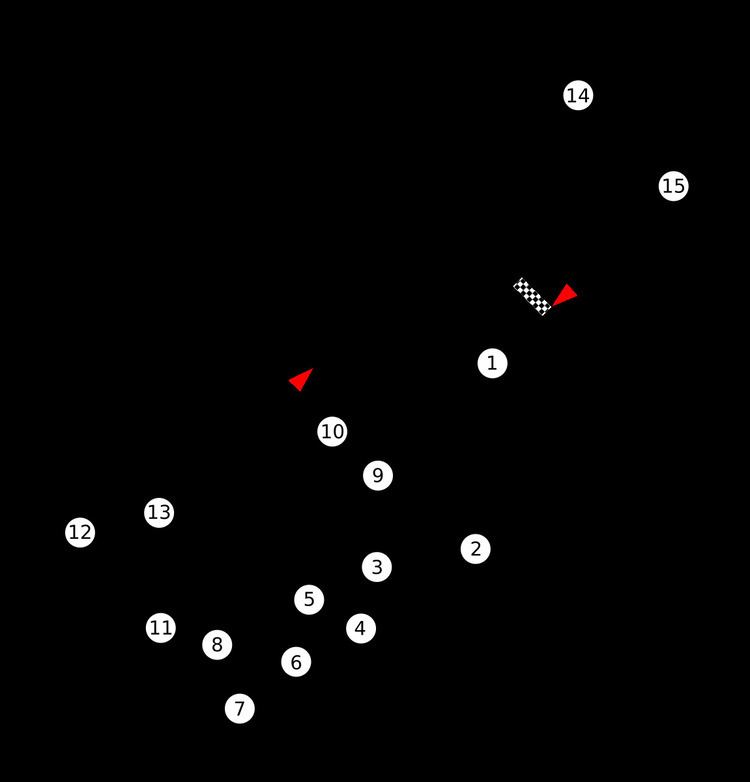Official name Winston Western 500 | ||
 | ||
Date November 8, 1987 (1987-November-08) Course Permanent racing facility2.700 mi (4.345 km) Distance 119 laps, 311.8 mi (501.7 km) Weather Mild with temperatures approaching 77 °F (25 °C); wind speeds up to 6 miles per hour (9.7 km/h) | ||
The 1987 Winston Western 500 was a NASCAR Winston Cup Series racing event that was held on November 8, 1987, at Riverside International Raceway in Riverside, California.
Contents
Rick Hendrick, Irv Hoerr and Tommy Kendall would make their respective debuts in the NASCAR Cup Series while George Follmer, Harry Goularte, Jim Robinson and Glen Steurer would leave the NASCAR Cup Series after this event. After this race, NASCAR would never hold the Winston Cup finale at Riverside International Speedway ever again; it eventually closed on July 2, 1989.
Bob Howard also entered (and at least practiced) his #89 Pennzoil Oldsmobile for this race. However, he had to withdraw from qualifying for this event due to personal reasons.
Summary
Approximately 18% of this event was held under a caution flag; with each green flag stretch lasting about 20 laps on average. 42 drivers would qualify for this 119-lap event.
Drivers who failed to qualify were St. James Davis, Trevor Boys, Reno Fontana, Jack Sellers, John Krebs, Bob Howard and Brad Noffsinger. Geoffrey Bodine was considered to be the poster boy for this race with his qualifying speed of up to 117.934 miles per hour (189.796 km/h). Rusty Wallace would ultimately race past Benny Parsons to the finish line by slightly more than a second. This would unfortunately mark the final win for the Pontiac 2+2. Only Rusty Wallace was able to win races with that model vehicle, and all of them were either on short tracks or road courses. Ironically, the Pontiac 2+2 was designed to be better aerodynamically at superspeedways such as Talladega and Daytona.
He would never finish in the "top five" in a NASCAR Cup Series event after this one. Four yellow flags would be given out at this event while no red flags were given out. Jack Sellers' qualifying speed of 102.736 miles per hour (165.338 km/h) made him the slowest driver not to qualify for the race. The owner of Hendrick Motorsports would bring home for his team a lowly 33rd-place finish after qualifying in a half-decent 21st place. The first caution for this event came when Hershel McGriff is given a hard bump by Morgan Shepherd right after his engine blew; resulting in his unfortunate last-place finish. While Geoffrey Bodine, George Follmer and Darrell Waltrip dominated the early stretch of the race, the later portions of the race were dominated by Geoffrey Bodine, Dale Earnhardt and Rusty Wallace.
Roy Smith would be the only foreigner to qualify for this event; he was from Canada. Vehicles from Chevrolet and Ford were primarily the vehicles that raced in this event. Jimmy Means would become the lowest-place finisher to actually complete the race. Individual race winnings for each driver varied from the winner's portion of $47,725 ($100,608.33 when adjusted for inflation) to the last-place finisher's portion of $2,525 ($5,322.91 when adjusted for inflation); although three drivers (who finished ahead of last place) were only awarded triple-digit prize winnings. NASCAR officials authorized a grand total of $307,325 to be given out to all the qualifying drivers in this racing event ($647,867.03 when adjusted for inflation). During the 1987 NASCAR Winston Cup Series season, there was three road course races on a schedule of 29 races. However, NASCAR would develop a liking for mile and a half tracks by the 2014 NASCAR Sprint Cup Series season.
After the conclusion of this racing event, NASCAR would never award less than $1,000 USD to any driver ever again ($2,108.08 when adjusted for inflation). Mark Martin would eventually return to the NASCAR Winston Cup Series for the 1988 season; racing for the legendary Jack Roush and carrying the #6 that would make him popular throughout the rest of the 1980s.
